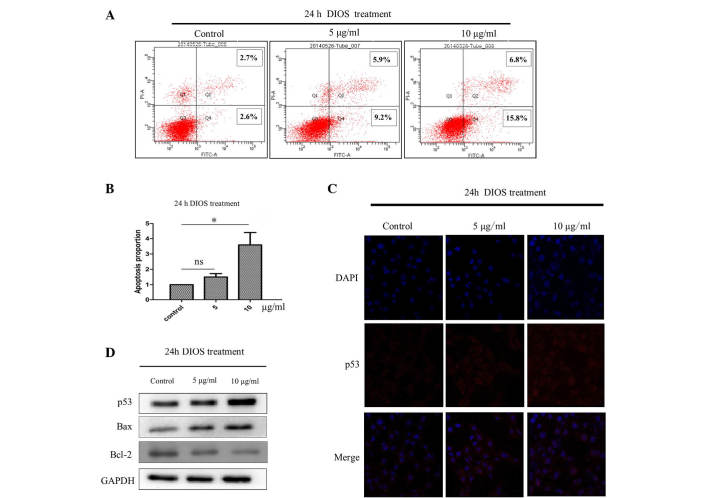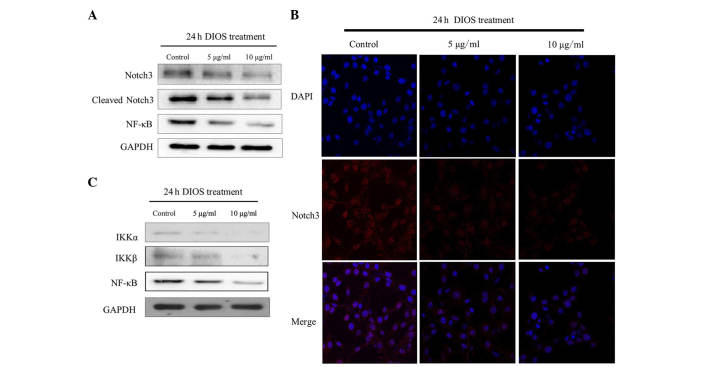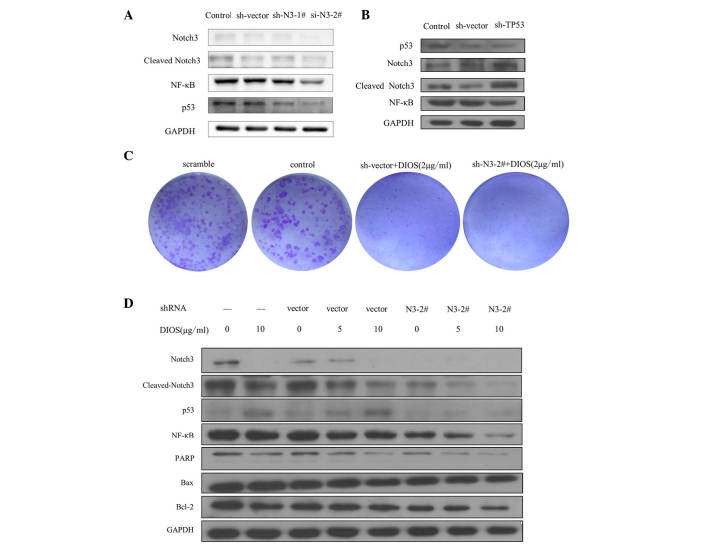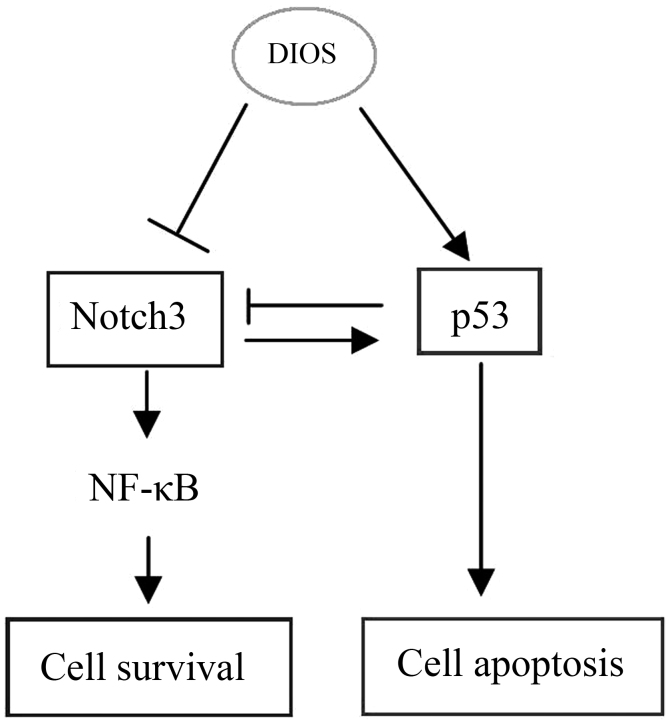Abstract
Diosmetin (DIOS), a flavonoid compound, is abundant in Citrus limon. Emerging studies have shown that DIOS is an effective compound implicated in multiple types of cancer. However, whether DIOS serves a role in hepatocellular carcinoma (HCC) is still obscure. HepG2 cells were used in the present study, and it was observed that DIOS exhibited antitumor activity against liver cancer cells. Western blotting was performed to evaluate cell apoptosis and survival-associated proteins, and the results demonstrated that DIOS treatment resulted in the activation of the p53-dependent apoptosis pathway. Our results revealed that DIOS caused inhibition of the nuclear factor (NF)-κB signaling pathway and downregulation of Notch3 receptor. Furthermore, by using small hairpin RNA-Notch3, it was confirmed that DIOS inhibited the NF-κB signaling pathway by inactivation of Notch3. In conclusion, the present results demonstrated that DIOS triggered cell apoptosis by activation of the p53 signaling pathway and inhibited the NF-κB cell survival pathway by downregulation of Notch3 receptor expression. DIOS is a potential agent for prevention of HCC.
Keywords: diosmetin, hepatocellular carcinoma, Notch3/NF-κB, p53/Bcl-2
Introduction
Primary liver cancer is the sixth most common cancer and the third most common cause of cancer mortality in the world (1). Over 90% of liver cancers are hepatocellular carcinoma (HCC) (2). Due to serious side effects and drug resistance, chemotherapy is not satisfactory for advanced HCC (3). Exploring novel anti-cancer compounds from natural drugs is an important way to combat HCC.
The identification of anti-cancer drugs from natural products is an important approach for the development of chemotherapeutics. Diosmetin (DIOS) is a kind of flavonoid that was identified in various dietary sources (4). The mechanism of DIOS intracellular antioxidant detoxifying action is associated with both non-enzymatic and enzymatic defense systems (5). DIOS could inhibit the activity of cytochrome P450, family 1, subfamily A, polypeptide 1 (CYP1A1) enzyme and the activation of carcinogens (6). DIOS could also activate c-Jun N-terminal kinase and extracellular signal-regulated kinase (ERK) and upregulate p53/p21 via inhibition of CYP1A-catalyzed metabolism in HepG2 cells (7). Our preliminary screening experiment indicated that DIOS had a significant role in inhibiting cell viability and inducing cell apoptosis in HepG2 cells (8). However, the antineoplastic activity of DIOS requires to be further investigated.
The Notch signaling pathway serves a key role in tumor development and progression (9). Notch3 and Notch4 were abnormally accumulated in 78 and 68% of HCC cases (10). Notch3 depletion increased p53 expression, sensitivity to doxorubicin and DNA damage, while ablating p53 expression in Notch3-knockdown cells largely abolished their enhanced doxorubicin sensitivity (11). In addition, knocking down Notch3 in Hep3B (p53-null) cells failed to influence their response to doxorubicin (11). In HCC, Notch3 could regulate tumor apoptosis at all stages of tumor development (12). Hu et al, using a meta-analysis on gene expression data of HCC cases from the Oncomine database (www.oncomine.org), identified that the Notch3 gene ranked as the highest upregulated Notch pathway member in HCC tissues compared with normal liver tissues (13). Notch3 was identified as a positive marker associated with aggressive traits and short survival in HCC, since patients with high levels of Notch3 expression commonly had a poor prognosis (13). The present authors also reported that Notch3 expression is inversely correlated with beta-catenin content but positively associated with the protein level of Nanog, thus confirming that Notch3 serves a role in modulating the stemness of tumor cells via the inactivation of the Wnt/beta-catenin pathway (14). Patients with high Notch1 or Notch3 expression were at a significantly increased risk for shortened survival time (15). Downregulation of Notch3 decreased the invasion capacity of HCC cells by regulating matrix metalloproteinase (MMP)-2 and MMP-9 via the ERK1/2 pathway (15). Notch3 regulates p53 at the post-transcriptional level by controlling both cyclin G1 expression and the cell signal transduction circuit, including microRNA-221 and mouse double minute 2 homolog in vitro and in vivo (16). Notch3 inhibition significantly increased the apoptosis effect induced by sorafenib in HCC cells via specific downregulation of p21 and upregulation of the phosphorylation of phospho-glycogen synthase kinase 3β Ser9 (17).
The nuclear factor (NF)-κB transcription factors serve an evolutionarily conserved and critical role in triggering the transcription of a variety of genes involved in inflammatory and immune responses, and are also involved in the control of cell proliferation, differentiation and apoptosis (18). Ent-11-hydroxy-15-oxo-kaur-16-en-19-oic-acid inhibited NF-κB by stabilizing its inhibitor IκBα, reducing the nuclear expression of NF-κB and inhibiting NF-κB activity (19). Subsequently, it affects the NF-κB downstream molecules via a decrease in anti-apoptotic B-cell lymphoma (Bcl)-2 and an increase in pro-apoptotic Bcl-2-like protein 4 (Bax) and Bcl-2 homologous antagonist/killer (20). Chemokine (C-X-C motif) ligand 1 upregulation may contribute to both the development and progression of HCC, and this effect may be associated with increased proliferation and invasiveness mainly via regulating NF-κB expression (21). The mechanism of HCC metastasis may mediate through cross-talk between the NF-κB and estrogen receptor (ER) signaling pathways (22). In addition, ERα regulated MMP-9 through NF-κB indirectly (22).
Targeted tumor drug is essential and reliable for application in the clinic. The present study attempted to confirm whether DIOS exhibited an anti-tumor capacity in HCC. Taking into account the role of Notch3 and NF-κB in the progression of HCC, the present study also explored if the two signaling pathways were involved in the progression of DIOS-mediated hepatoma cell apoptosis. These results will advance the knowledge of DIOS for further application in HCC.
Materials and methods
Cell culture and treatment
The human hepatic cell line HepG2 (catalogue number TCHu72) was used in the present study. The cells were obtained from the Cell Bank of Shanghai Institutes for Biological Sciences (Shanghai, China). The cells were cultured in RPMI 1640 medium supplemented with 10% fetal bovine serum (Gibco; Thermo Fisher Scientific, Inc., Waltham, MA, USA) and maintained at 37°C in a cell culture incubator with a humidified atmosphere and 5% CO2. DIOS powder was dissolved in dimethyl sulfoxide (DMSO) (Sigma-Aldrich; Merck Millipore, Darmstadt, Germany) to create a stock at a concentration of 10 mg/ml, which was subsequently diluted in culture medium to the corresponding concentration for subsequent experiments. DMSO was used as the vehicle control in the experiments.
MTT assay
Cells were seeded in 96-well plates at a density of 5,000–10,000 cells per well. After 24 h of treatment, DIOS (four replicates in each group) was added at different concentrations for various time periods. Then, 20 µl MTT solution (5 mg/ml) was added to each well, and the plates were incubated at 37°C for 4 h. The medium was removed, and 150 µl DMSO was added to dissolve the formazan crystals. The absorbance at 492 nm was measured using a spectrophotometer.
Apoptosis assay
Cell apoptosis was detected using an Annexin V-fluorescein isothiocyanate (FITC)/propidium iodide apoptosis detection kit (BioVision, Inc., Milpitas, CA, USA) according to the manufacturer's protocol. Cells were seeded in 6-well plates at a density of ~5×105 cells/ml. The cells were treated with DIOS at different concentrations (0, 5 and 10 µg/ml) and incubated at 37°C for 24 h. Subsequently, the cells were harvested and washed with PBS three times. Cells were resuspended in Annexin V binding buffer and labeled with the above Annexin V-FITC/PI apoptosis detection kit, and then analyzed by flow cytometry.
Immunoblotting analysis
Antibodies specific for the following proteins were purchased from Cell Signaling Technology, Inc. (Danvers, MA, USA) and used at a 1:1,000 dilution: Notch3/cleaved Notch3 (#5276), NF-κB (#8242), p53 (#2527), PARP (#9532), IκB kinase (IKK)α (#11930), IKKβ (#8943) and GAPDH (#2118). Horseradish peroxidase-conjugated secondary antibodies included anti-rabbit (#E030120-01) anti-mouse (#E030110-02) antibodies at a dilution of 1:3,000 in TBST and were obtained from EarthOx Life Sciences (Millbrae, CA, USA). Following protein transferal, the membrane was blocked with 5% non-fat milk at room temperature for 1 h and incubated with primary antibodies at 4̊C overnight. The membranes were washed three times for 5 min each time to remove unbinding antibodies and then incubated with the secondary antibodies at room temperature for 1–2 h. The membranes were washed again three times (5 min each time). Enhanced chemiluminescence buffer was applied to produce the protein signal and visualized using an x-ray film. The cells were treated with DIOS at different concentrations (0, 5 and 10 µg/ml) and incubated for 24 h at 37°C. Protein samples were treated with radioimmunoprecipitation assay cell lysis buffer (final phenylmethylsulfonyl fluoride concentration, 1 mM). Western blots were performed as previously described (23).
Immunofluorescence (IF)
Cells (1×105) were plated in IF dishes (NEST Biotechnology, Wuxi, China) and treated with DIOS. Then, the cells were fixed in paraformaldehyde and permeabilized with 0.01% Triton X-100. Next, the cells were incubated with primary antibodies against p53 (#2527) and Notch3 (#5276) [1:500 dilution with 5% bovine serum albumin (BSA) in PBS; Cell Signaling Technology, Inc.] at 4°C overnight upon blocking the cells with 5% BSA dilution in PBS. DyLight™ 649-conjugated secondary antibodies (#009-490-006; Jackson ImmunoResearch Laboratories, Inc., West Grove, PA, USA) were applied at a dilution of 1:500 at room temperature for 1 h. The specimens were monitored using a TCP SP5 laser microscope (Leica Microsystems GmbH, Wetzlar, Germany).
Notch3 interference
A specific small hairpin (sh)RNA targeting the Notch3 gene and a control shRNA (synthesized by Sangon Biotech Co., Ltd., Shanghai, China) were constructed into lenti-shRNA vectors, which were purchased from (GeneChem Co., Ltd., Shanghai, China). Upon virus production, these virus were transfected into HepG2 cell lines. Notch3 stable-depleted cells were obtained after 7 days of selection with puromycin. The cells were seeded in 6-cm plates for subsequent experiments.
Clone formation test
Three groups of cells (HepG2 control, shRNA-vector-treated and shRNA-Notch3-treated cells) were plated in 6-well plates at ~1,000 cells/well and incubated for 7 days at 37°C. The medium was then removed and the cells were washed once with water. The clones were stained with crystal violet for 30 min and images were captured of the air-dried plate.
Statistical analysis
The data were analyzed with GraphPad Prism 5 (GraphPad Software, Inc., La Jolla, CA, USA), and one-way analysis of variance was performed to compare differences between groups. All results shown represent means ± standard deviation from triplicate experiments performed in a parallel manner, unless otherwise indicated. All figures shown in the present study were obtained from at least three independent experiments. P<0.05 was considered to indicate a statistically significant difference.
Results
DIOS induces apoptosis and inhibits cell proliferation in HepG2 cells
HepG2 cells were seeded at a density of 3×105 cells/cm2 12 h prior to DIOS treatment. The cells were exposed to three DIOS concentrations (0, 5 and 10 µg/ml), and DMSO served as the drug vehicle. The data indicated that DIOS induced cell apoptosis and inhibited cell proliferation in HepG2 cells in a dose- and time-dependent manner (Fig. 1A and B). Under light microscopy, the number of normal cells was significantly reduced, while the number of dead cells increased with time or dose. MTT analysis was used to evaluate the inhibitory effects and cytotoxicity of DIOS treatment in HepG2 cells. The data indicated that the cytotoxicity of DIOS increased in a concentration-dependent manner. The inhibitory concentration 50 of DIOS in HepG2 cells was 25 µg/ml for 24-h treatment (Fig. 1C).
Figure 1.
DIOS induces cell apoptosis in HepG2 cells. (A and B) DIOS induced cell apoptosis under different (A) concentrations and (B) duration of DIOS treatment, as monitored by a phase-contrast microscope (magnification, ×200). (C) Cell viability was measured by the MTT method after exposure to DIOS for 24 h (five replicates for each concentration). DIOS, diosmetin.
DIOS induces cell apoptosis by activation of the p53 signaling pathway
Annexin V-FITC/PI double staining assay was performed to detect cell apoptosis in HepG2 cells subjected to DIOS treatment. The results indicate that DIOS could significantly induce cell apoptosis in HepG2 cells (P<0.05; Fig. 2A and B). IF indicated that p53 was upregulated following DIOS exposure by p53-specific antibody-mediated IF staining (Fig. 2C). By using western blotting, it was observed that the levels of p53 protein and its downstream target proteins were upregulated, while the levels of another anti-apoptotic protein, Bcl-2, were decreased (Fig. 2D).
Figure 2.
DIOS induces cell apoptosis via activation of the p53 pathway. (A) Cell apoptosis was detected using an Annexin V-FITC/PI double staining cell apoptosis detection kit. (B) Statistical analysis of cell apoptosis via flow cytometry. (C) The p53 cellular location and protein levels were analyzed by immunofluorescence (magnification, ×200). (D) p53, Bax, Bcl-2 and GAPDH were detected by immunoblotting. DIOS, diosmetin; Bcl, B-cell lymphoma; Bax, Bcl-2-like protein 4; FITC, fluorescein isothyocianate; PI, propidium iodide.
DIOS downregulates the Notch3 and NF-κB signaling pathways
HepG2 cells were treated with various concentrations of DIOS for 24 h. Notch3 and cleaved Notch3 protein levels were determined by western blotting, and it was noticed that Notch3, cleaved Notch3 and NF-κB were downregulated following DIOS exposure (Fig. 3A). It was confirmed that Notch3 expression was downregulated using IF staining (Fig. 3B). It was demonstrated that the inhibition of NF-κB resulted from the inactivation of IKKα and IKKβ (Fig. 3C). These results indicated that DIOS could regulate the Notch3 signaling pathway by modulating the Notch3 receptor level and Notch3 activation processes.
Figure 3.
DIOS downregulates Notch3 signaling and inhibits the NF-κB pathway by inactivation of its upstream regulator IKKα/IKKβ. (A) Notch3, cleaved Notch3 and NF-κB were detected by immunoblotting. (B) The p53 cellular location and protein level was analyzed by immunofluorescence (magnification, ×200). (C) IKKα, IKKβ and NF-κB protein level alterations were determined following DIOS stimulation. DIOS, diosmetin; NF, nuclear factor; IKK, IκB kinase.
DIOS disturbs the balance between Notch3 and p53 and results in the inhibition of the NF-κB signaling pathway
Specific small interfering RNAs for Notch3 and p53 were applied for gene knockdown (Fig. 4A and B). Deletion of Notch3 inhibited p53 expression, while knockdown of p53 upregulated Notch3 receptor content and enhanced the release of cleaved Notch3. These results indicated that p53 negatively regulated the Notch3 pathway, while Notch3 promoted p53 expression, which suggests that there is negative feedback regulation between Notch3 and p53. Additionally, reduced expression of Notch3 led to a lower expression of NF-κB and p53. p53 knockdown induced Notch3 receptor upregulation, release of cleaved Notch3 and downregulation of NF-κB (Fig. 4B). It was identified that Notch3 inhibition enhanced the DIOS-caused damage of clone forming ability in HepG2 cells (Fig. 4C). Evaluation of DIOS-treated HepG2 cells, Notch3-control HepG2 cells and Notch3-knockdown HepG2 cells revealed that downregulation of Notch3 rescues the p53 upregulation induced by DIOS treatment. Deletion of Notch3 enhanced the reduction in NF-κB levels that was mediated by DIOS exposure. The apoptotic proteins Bax and poly (ADP-ribose) polymerase (PARP) were upregulated, while the anti-apoptotic protein Bcl-2 was downregulated (Fig. 4D). The data indicated that DIOS treatment could inhibit the NF-κB pathway and activate the apoptosis pathway.
Figure 4.
DIOS disturbs the balance between Notch3 and p53 and resulted in the inhibition of the NF-κB signaling pathway. (A) Notch3, NF-κB and p53 protein levels were determined by immunoblotting following knockdown of Notch3 by siRNA transfection. (B) Notch3, NF-κB and p53 were detected by immunoblotting following knockdown of p53 by siRNA transfection. (C) The clone formation ability of HepG2 cells was tested upon blocking Notch3, following DIOS treatment alone or subsequent to a combination of the two approaches. (D) Notch3, p53, NF-κB, Bax, Bcl-2 and PARP were detected when Notch3 was blocked with DIOS treatment. DIOS, diosmetin; NF, nuclear factor; Bcl, B-cell lymphoma; Bax, Bcl-2-like protein 4;; PARP, poly (ADP-ribose) polymerase; sh, small hairpin; si, small interfering.
Discussion
DIOS has been reported to be able to induce cell apoptosis and to act as an anti-cancer compound in HepG2 cells (7). Our results indicated that DIOS could induce cell apoptosis and inhibit cell viability in HepG2 cells in a time- and concentration-dependent manner. The present study confirmed that DIOS treatment could lead to cell apoptosis by upregulation of Bax and reduced Bcl-2 expression levels via the p53 pathway, which resulted in cell apoptosis.
Emerging studies have revealed that Notch3 is aberrantly expressed in tumor tissues of HCC patients and serves a vital role in modulating tumor proliferation, differentiation and migration (10,15). Notch3 was downregulated following DIOS treatment in HepG2 cells. We propose that Notch3 inhibition enhances the DIOS-induced cell death in HepG2 cells. It was also confirmed that inhibition of Notch3 disturbs the capacity of clone formation of these cells. The association between p53 and Notch3 was investigated, and it was observed that inhibition of Notch3 inhibits the expression of p53. However, deletion of p53 promotes Notch3 expression. These results strongly indicate that there is a balance between Notch and p53 levels by a negative feedback in DIOS treatment. DIOS treatment directly upregulated p53 in wild-type HepG2 cells but did not have a significant influence on p53 in Notch3-knockdown cells. We conclude that Notch3 promotes p53 expression in normal physiological conditions, while DIOS treatment inhibits Notch3 expression and upregulates p53 expression. DIOS exposure finally activates the p53/Bcl-2/PARP cell apoptosis pathway.
The NF-κB signaling pathway is involved in cell growth and cell death (24). NF-κB signal deregulation resulted in cell abnormal proliferation and resistance to the signals of cell programed cell death. NF-κB activation is an important cause of tumorigenesis (25). In the present study, it was observed that DIOS decreased NF-κB signaling in a Notch3-dependent manner. The current study demonstrated that DIOS inhibits NF-κB by downregulation of the IKKα/β, which promotes the release of NF-κB.
In conclusion, the current study reports that DIOS inhibits cell viability and promotes cell apoptosis by activation of the p53-mediated cell apoptosis pathway. It was also observed that DIOS treatment could decrease NF-κB signaling by downregulation of IKKα/β, which resulted in the downregulation of Notch3 receptor expression. The present authors propose that DIOS is a promising compound for HCC chemotherapeutic development.
Figure 5.
Signaling network involved in the DIOS-induced cell apoptosis in HepG2 cells. DIOS, diosmetin; NF, nuclear factor.
Acknowledgements
The present study was supported in part by the Yangfan Plan of Talents Recruitment Grant, Guangdong, China (2016), the Science and Technology Innovation Fund of Guangdong Medical College (Zhanjiang, China; grant number STIF201107), the Doctoral Initial Funding of Guangdong Medical College (Zhanjiang, China; grant number B2012039) and the Guangdong Medical Science Foundation (Zhanjiang, China; grant number B2014308).
References
- 1.Torre LA, Bray F, Siegel RL, Ferlay J, Lortet-Tieulent J, Jemal A. Global cancer statistics, 2012. CA Cancer J Clin. 2015;65:87–108. doi: 10.3322/caac.21262. [DOI] [PubMed] [Google Scholar]
- 2.Herszenyi L, Tulassay Z. Epidemiology of gastrointestinal and liver tumors. Eur Rev Med Pharmacol Sci. 2010;14:249–258. [PubMed] [Google Scholar]
- 3.Deng GL, Zeng S, Shen H. Chemotherapy and target therapy for hepatocellular carcinoma: New advances and challenges. World J Hepatol. 2015;7:787–798. doi: 10.4254/wjh.v7.i5.787. [DOI] [PMC free article] [PubMed] [Google Scholar]
- 4.Mueller M, Hobiger S, Jungbauer A. Anti-inflammatory activity of extracts from fruits, herbs and spices. Food Chemistry. 2010;122:987–996. doi: 10.1016/j.foodchem.2010.03.041. [DOI] [Google Scholar]
- 5.Liao W, Ning Z, Chen L, Wei Q, Yuan E, Yang J, Ren J. Intracellular antioxidant detoxifying effects of diosmetin on 2,2-azobis (2-amidinopropane) dihydrochloride (AAPH)-induced oxidative stress through inhibition of reactive oxygen species generation. J Agric Food Chem. 2014;62:8648–8654. doi: 10.1021/jf502359x. [DOI] [PubMed] [Google Scholar]
- 6.Ciolino HP, Wang TT, Yeh GC. Diosmin and diosmetin are agonists of the aryl hydrocarbon receptor that differentially affect cytochrome P450 1A1 activity. Cancer Res. 1998;58:2754–2760. [PubMed] [Google Scholar]
- 7.Androutsopoulos VP, Spandidos DA. The flavonoids diosmetin and luteolin exert synergistic cytostatic effects in human hepatoma HepG2 cells via CYP1A-catalyzed metabolism, activation of JNK and ERK and P53/P21 upregulation. J Nutr Biochem. 2013;24:496–504. doi: 10.1016/j.jnutbio.2012.01.012. [DOI] [PubMed] [Google Scholar]
- 8.Liu B, Shi Y, Peng W, Zhang Q, Liu J, Chen N, Zhu R. Diosmetin induces apoptosis by upregulating p53 via the TGF-β signal pathway in HepG2 hepatoma cells. Mol Med Rep. 2016;14:159–164. doi: 10.3892/mmr.2016.5258. [DOI] [PMC free article] [PubMed] [Google Scholar]
- 9.Grego-Bessa J, Díez J, Pompa JL. Notch and epithelial-mesenchyme transition in development and tumor progression: another turn of the screw. Cell cycle. 2004;3:716–719. doi: 10.4161/cc.3.6.949. [DOI] [PubMed] [Google Scholar]
- 10.Gramantieri L, Giovannini C, Lanzi A, Chieco P, Ravaioli M, Venturi A, Grazi GL, Bolondi L. Aberrant Notch3 and Notch4 expression in human hepatocellular carcinoma. Liver Int. 2007;27:997–1007. doi: 10.1111/j.1478-3231.2007.01544.x. [DOI] [PubMed] [Google Scholar]
- 11.Giovannini C, Gramantieri L, Chieco P, Minguzzi M, Lago F, Pianetti S, Ramazzotti E, Marcu KB, Bolondi L. Selective ablation of Notch3 in HCC enhances doxorubicin's death promoting effect by a p53 dependent mechanism. J Hepatol. 2009;50:969–979. doi: 10.1016/j.jhep.2008.12.032. [DOI] [PubMed] [Google Scholar]
- 12.Konishi J, Yi F, Chen X, Vo H, Carbone DP, Dang TP. Notch3 cooperates with the EGFR pathway to modulate apoptosis through the induction of bim. Oncogene. 2010;29:589–596. doi: 10.1038/onc.2009.366. [DOI] [PMC free article] [PubMed] [Google Scholar]
- 13.Hu L, Xue F, Shao M, Deng A, Wei G. Aberrant expression of Notch3 predicts poor survival for hepatocellular carcinomas. Biosci Trends. 2013;7:152–156. [PubMed] [Google Scholar]
- 14.Zhang Q, Lu C, Fang T, Wang Y, Hu W, Qiao J, Liu B, Liu J, Chen N, Li M, Zhu R. Notch3 functions as a regulator of cell self-renewal by interacting with the β-catenin pathway in hepatocellular carcinoma. Oncotarget. 2015;6:3669–3679. doi: 10.18632/oncotarget.2898. [DOI] [PMC free article] [PubMed] [Google Scholar]
- 15.Zhou L, Zhang N, Song W, You N, Li Q, Sun W, Zhang Y, Wang D, Dou K. The significance of Notch1 compared with Notch3 in high metastasis and poor overall survival in hepatocellular carcinoma. PLoS One. 2013;8:e57382. doi: 10.1371/journal.pone.0057382. [DOI] [PMC free article] [PubMed] [Google Scholar] [Retracted]
- 16.Giovannini C, Minguzzi M, Baglioni M, Fornari F, Giannone F, Ravaioli M, Cescon M, Chieco P, Bolondi L, Gramantieri L. Suppression of p53 by Notch3 is mediated by Cyclin G1 and sustained by MDM2 and miR-221 axis in hepatocellular carcinoma. Oncotarget. 2014;5:10607–10620. doi: 10.18632/oncotarget.2523. [DOI] [PMC free article] [PubMed] [Google Scholar]
- 17.Giovannini C, Baglioni M, Toaldo M Baron, Ventrucci C, D'Adamo S, Cipone M, Chieco P, Gramantieri L, Bolondi L. Notch3 inhibition enhances sorafenib cytotoxic efficacy by promoting GSK3b phosphorylation and p21 downregulation in hepatocellular carcinoma. Oncotarget. 2013;4:1618–1631. doi: 10.18632/oncotarget.1221. [DOI] [PMC free article] [PubMed] [Google Scholar]
- 18.Vacca A, Felli MP, Palermo R, Di Mario G, Calce A, Di Giovine M, Frati L, Gulino A, Screpanti I. Notch3 and pre-TCR interaction unveils distinct NF-kappaB pathways in T-cell development and leukemia. EMBO J. 2006;25:1000–1008. doi: 10.1038/sj.emboj.7600996. [DOI] [PMC free article] [PubMed] [Google Scholar]
- 19.Ihekwaba AEC, Broomhead DS, Grimley RL, Benson N, Kell DB. Sensitivity analysis of parameters controlling oscillatory signalling in the NF-κB pathway: The roles of IKK and IκBα. Syst Biol. 2004;1:93–103. doi: 10.1049/sb:20045009. [DOI] [PubMed] [Google Scholar]
- 20.Chen GG, Leung J, Liang NC, Li L, Wu K, Chan UP, Leung BC, Li M, Du J, Deng YF, et al. Ent-11alpha-hydroxy-15-oxo-kaur-16-en-19-oic-acid inhibits hepatocellular carcinoma in vitro and in vivo via stabilizing IkBα. Invest New Drugs. 2012;30:2210–2218. doi: 10.1007/s10637-011-9791-5. [DOI] [PubMed] [Google Scholar]
- 21.Cao Z, Fu B, Deng B, Zeng Y, Wan X, Qu L. Overexpression of Chemokine (C-X-C) ligand 1 (CXCL1) associated with tumor progression and poor prognosis in hepatocellular carcinoma. Cancer Cell Int. 2014;14:86. doi: 10.1186/s12935-014-0086-8. [DOI] [PMC free article] [PubMed] [Google Scholar]
- 22.Sheng ML, Xu GL, Zhang CH, Jia WD, Ren WH, Liu WB, Zhou T, Wang YC, Lu ZL, Liu WF, et al. Aberrant estrogen receptor alpha expression correlates with hepatocellular carcinoma metastasis and its mechanisms. Hepatogastroenterology. 2014;61:146–150. [PubMed] [Google Scholar]
- 23.Wu M, Stockley PG, Martin WJ., II An improved western blotting technique effectively reduces background. Electrophoresis. 2002;23:2373–2376. doi: 10.1002/1522-2683(200208)23:15<2373::AID-ELPS2373>3.0.CO;2-W. [DOI] [PubMed] [Google Scholar]
- 24.Beg AA, Baltimore D. An essential role for NF-κB in preventing TNF-alpha-induced cell death. Science. 1996;274:782. doi: 10.1126/science.274.5288.782. [DOI] [PubMed] [Google Scholar]
- 25.Pikarsky E, Porat RM, Stein I, Abramovitch R, Amit S, Kasem S, Gutkovich-Pyest E, Urieli-Shoval S, Galun E, Ben-Neriah Y. NF-kappaB functions as a tumour promoter in inflammation-associated cancer. Nature. 2004;431:461–466. doi: 10.1038/nature02924. [DOI] [PubMed] [Google Scholar]







